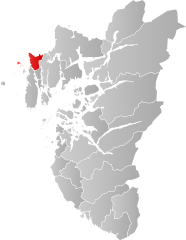Haugesund
| gmina | |||||
 | |||||
| |||||
| Państwo | |||||
|---|---|---|---|---|---|
| Region | Rogaland | ||||
| Siedziba | Haugesund | ||||
| Kod statystyczny | 1106 | ||||
| Powierzchnia | 72,26 km² | ||||
| Populacja • liczba ludności | 31 530 | ||||
| • gęstość | 436,34 os./km² | ||||
Adres urzędu: Kirkegt. 855504 HAUGESUND | |||||
Położenie na mapie okręgu | |||||
| Strona internetowa | |||||
| Portal | |||||
Haugesund – norweskie miasto i gmina leżąca w regionie Rogaland.
Haugesund jest 403. norweską gminą pod względem powierzchni. Niewielki port morski.
Historia
Gmina Haugesund powstała w 1854, poprzez wydzielenie jej z gminy Torvastad. W 1866 uzyskała tytuł kjøpstad – miasta targowego. W dwóch etapach, w 1911 i 1958, w dzielnice Haugesundu włączono gminę Skåre. Miasto osiągnęło obecne granice w 1965[1].
Atrakcje turystyczne
- Haraldshaugen – pomnik zjednoczenia Norwegii;
- latarnia morska Røværsholmen.
Obiekty sakralne
- kościół Naszego Zbawiciela (Vår Frelsers kirke),
- kościół w Skåre (Skåre kirke);
- kościół św. Józefa (St. Josef kirke).
Demografia
Według danych z roku 2005 gminę zamieszkuje 31 530 osób. Gęstość zaludnienia wynosi 436,34 os./km². Pod względem zaludnienia Haugesund zajmuje 24. miejsce wśród norweskich gmin.
| ludność stan na 1 stycznia 2005 | |||
| kobiety | mężczyźni | razem | |
|---|---|---|---|
| osób | 15 545 | 15 985 | 31 530 |
| % | 49,3% | 50,7% | 100% |
| wykształcenie stan na 1 października 2004 | ||||
| podst. | średnie | wyższe | niezn. | |
|---|---|---|---|---|
| osób | 3922 | 14 780 | 5612 | 697 |
| % | 15,68% | 59,09% | 22,44% | 2,79% |
Edukacja
Według danych z 1 października 2004:
- liczba szkół podstawowych (norw. grunnskolar): 13
- liczba uczniów szkół podstawowych: 4129
Sport
- FK Haugesund - klub piłkarski
- Haugar Haugesund - klub piłkarski
- SK Vard Haugesund - klub piłkarski
- Haugesund IL - klub lekkoatletyczny
- Haugesund Stadion - stadion klubów
Władze gminy
Według danych na rok 2011 administratorem gminy (norw. rådmann) jest Odd Henry Dahle, natomiast burmistrzem (norw. ordfører, d. borgermester) jest Petter Steen jr.
Zobacz też
Przypisy
Bibliografia
- dane liczbowe: Statistisk sentralbyrå
- dane adresowe i dotyczące władz: Kommunenøkkelen
Media użyte na tej stronie
Kommunevåpen for Haugesund kommune i Rogaland fylke.
The flag of the municipality of Haugesund in the county of Rogaland, Norway. Its design is shared with the municipal arms, and shows three gulls, a motif very loosely based upon the previous city arms, which were adopted in 1862. This original design depicted three open barrels of herring and an anchor. These were set against a background consisting of a naturalistic landscape scene, which included three gulls flying in the sky. In terms of symbolism, the aforesaid focal objects represented the city's foundation upon herring and shipping. The number of barrels additionally stood for the three main parts of Haugesund: the mainland, as well as the islands of Risøy and Hasseløy.
In the 20th century, the arms of the city would however become subject to debate, when it came to attention that they were not actually heraldically correct. They would thus not be approvable by the Norwegian government. This led to some differing opinions about how the situation ought to have been resolved, including just keeping the arms without central approval. Those on the other side of the debate had instead effectuated several alternative proposals. Eventually, the city council would decide to take the latter route. Hallvard Trætteberg, who would later become Norway's foremost heraldist, is the author of the proposal that was finally chosen. His design took what was just a background element in the 1862 arms, the gulls, and made them the only charge. The composition's threefoldness was also preserved. As for the symbolism, the gulls are said to gather where there is nourishment to be found, and are explained as representing "the city which gets its livelihood from the sea [...] herring fishing [...] shipping".
By the time that Hallvard Trætteberg could present his proposal on December 7th, 1929, the matter had become rather pressing, as the city now desired officially approved arms to go along with the new city hall, which was nearing completion. The new, simpler design would thanks to its heraldic correctness also be usable as a vexillographically appropriate flag, in the form of a banner of arms. And so, on December 17th, the city council decided upon the new arms and a matching flag. Finally, the following year, the council's decision was approved by royal resolution 1930‐03‐05.Map showing the position of Haugesund within Rogaland, made by Jon Harald Søby.






